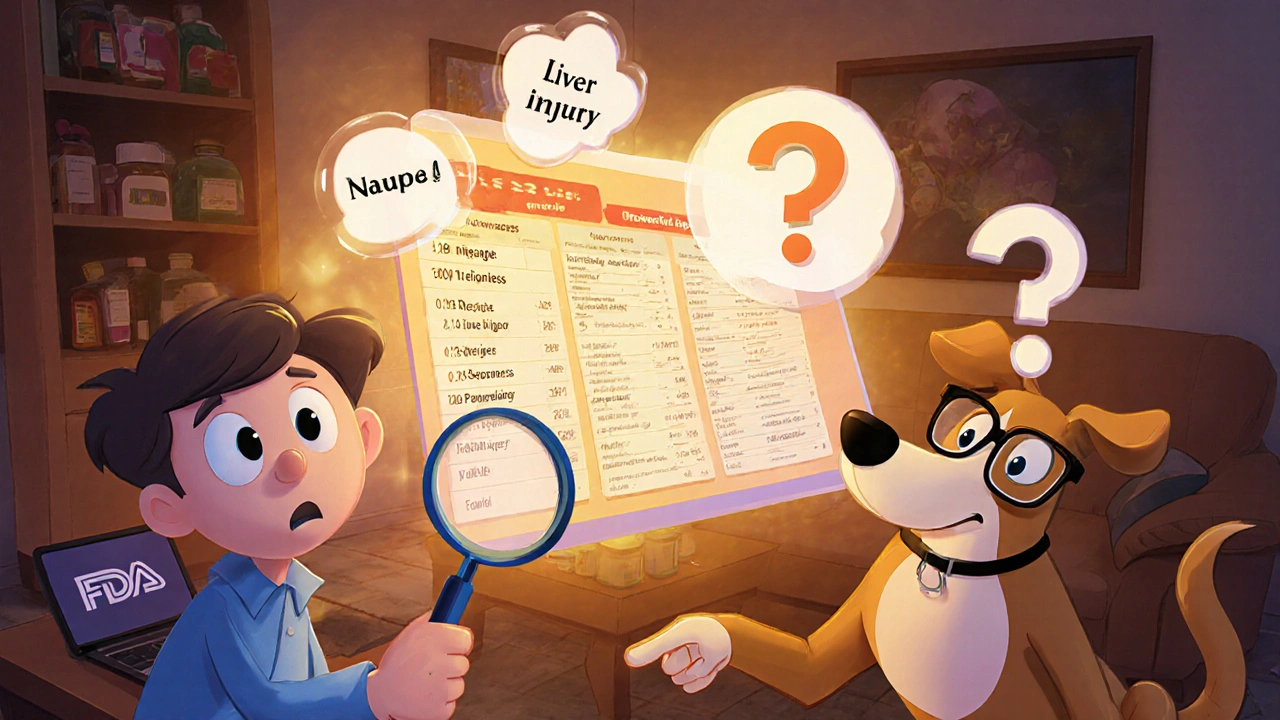Searching FAERS Side Effect Reports: Practical Tips for Patients and Researchers

FAERS Side Effect Reporting Rate Calculator
This tool calculates reporting rates from FAERS data to help you understand what raw numbers mean. Remember: FAERS reports don't equal actual risk. Without knowing how many people took the drug, you can't calculate true risk.
Important: The FDA calls FAERS a "signal detection" tool. Reporting rates only show what was reported, not actual risk. Context matters more than raw numbers.
Reporting Rate Calculation
Reporting rate = per 100,000 users
This is the number of reports divided by the estimated number of users, scaled to 100,000 people
Remember: This rate only shows what was reported, not actual risk. FAERS doesn't tell you how many people actually experienced the side effect. A high rate could be due to:
- High awareness of the side effect
- Underreporting of less obvious side effects
- Concurrent use of multiple drugs
- Population differences (age, gender, etc.)
When you’re trying to understand if a medication might cause serious side effects, the FDA’s FAERS database is one of the most powerful tools available. But it’s not a simple lookup. If you type in a drug name and expect a clear list of dangers, you’ll get misleading results. FAERS doesn’t tell you how common a side effect is - it tells you what people reported. And that’s a big difference.
What FAERS Actually Shows You
FAERS, or the FDA Adverse Event Reporting System, collects reports of problems linked to drugs and biologics after they’re on the market. It’s not a list of confirmed side effects. It’s a pile of reports - from doctors, pharmacists, patients, and drug companies - that say, "This happened after I took this medicine."
As of Q3 2024, FAERS held over 2.7 million reports where only one drug was involved. That’s a lot of data. But here’s the catch: most of those reports - about 75% - come from drug manufacturers who got them from healthcare providers or patients. The FDA doesn’t verify each one. There’s no lab test, no medical record check. Just a report.
That means if 100 people report nausea after taking Drug X, it doesn’t mean 100 people got sick from it. Maybe 10,000 people took the drug and only 100 reported it. Or maybe 100 people reported it because they saw a news story about it. FAERS doesn’t tell you the denominator - how many people used the drug. That’s why you can’t calculate risk from FAERS alone.
How to Search FAERS Correctly
The FDA’s FAERS Public Dashboard is free and easy to use. Go to the site, click the blue search bar, and type in a drug name. You’ll see a graph showing how many reports came in each year. But that’s just the start.
To see actual side effects, use the drop-down menu on the right and select "cases by reaction." Now you’ll see a list of symptoms people reported - things like dizziness, liver injury, or heart palpitations. But don’t stop there.
Drugs have brand names and generic names. If you only search "Lipitor," you’ll miss reports under "atorvastatin." Search both. The dashboard lets you enter up to five drug names at once. Use that. Compare similar drugs. See if one has more reports of a specific reaction than another.
Filter by age, gender, and report year. If you’re looking at a drug used mostly by older adults, check the reports from people over 65. You might see a pattern that’s hidden in the overall data.
What FAERS Won’t Tell You
FAERS is great for spotting signals - unusual clusters of reports that might mean something’s wrong. But it’s terrible for proving cause and effect.
Let’s say you see 50 reports of sudden kidney failure linked to Drug Y. That sounds scary. But maybe Drug Y is prescribed to people who already have kidney disease. Maybe the reports are from a single hospital where a batch of the drug was contaminated. Maybe patients were taking five other drugs at the same time.
FAERS doesn’t capture any of that context. That’s why the FDA calls it a "signal detection" tool. It’s like a smoke alarm. It doesn’t tell you if there’s a fire - it just tells you something’s wrong and you should look closer.
Experts like Madris Kinard, who used to work in FDA safety monitoring, say FAERS data has "limited value unless someone is closely monitoring a specific medication." That’s the key. Don’t use it to scare yourself. Use it to ask better questions.

Advanced Tools: VisDrugs and PharmaPendium
If you’re a researcher, clinician, or someone who needs to dig deeper, the Public Dashboard isn’t enough. That’s where tools like VisDrugs and PharmaPendium come in.
VisDrugs is a free web tool built specifically to make FAERS data easier to understand. It shows pie charts of the most common side effects and forest plots that compare how often a reaction happens with one drug versus another. You can even compare two groups of drugs side by side. Want to know if Drug A causes more joint pain than Drug B? VisDrugs can show you that - with statistical measures like reporting odds ratios.
PharmaPendium, from Elsevier, is another option. It lets you use logic operators like AND, OR, and NOT to build complex searches. You can filter by reporter type (doctor vs. patient), age range, gender, and outcome (hospitalization, death, disability). It’s powerful - but it’s not free.
Both tools help you move beyond simple counts. They help you see patterns, not just numbers.
Real-Time Updates Changed Everything
Before August 2024, FAERS updated every three months. That meant if a new safety issue popped up in January, you wouldn’t see it until April. That delay could cost lives.
Now, the FDA updates FAERS in real time. Reports flow in as they’re received. That’s a huge leap forward. It means researchers can spot emerging trends faster. It means the FDA can act quicker - like adding a black box warning or pulling a drug off the market.
But real-time doesn’t mean perfect. The data is still messy. The same reporting biases still exist. Underreporting is still common. And without knowing how many people took the drug, you’re still guessing at risk.

Don’t Confuse FAERS with MAUDE
If you’re looking for side effects from a medical device - a pacemaker, a joint implant, a glucose monitor - don’t use FAERS. Use MAUDE, the Manufacturer and User Facility Device Experience database.
Device names are tricky. One company makes five versions of the same device. Two different devices have almost identical names. Searching "knee replacement" in MAUDE will give you hundreds of irrelevant results. You need the exact model number. If you don’t know it, check your medical records. Your doctor’s office can give you a copy.
FAERS is for drugs. MAUDE is for devices. Mixing them up will lead you to the wrong conclusions.
What to Do With This Information
FAERS isn’t a safety verdict. It’s a starting point.
If you’re a patient and you see a scary side effect listed in FAERS, talk to your doctor. Ask: "Is this common? Is it likely linked to the drug? Are there safer alternatives?"
If you’re a researcher, use FAERS to find signals - then design a real study to test them. Look at the patterns. Compare drugs. Filter by age. Look for clusters.
If you’re a lawyer or advocate working on a case, FAERS can help build a timeline of reported problems. But you’ll still need medical records, prescriptions, and expert testimony to prove causation.
Remember: The FDA doesn’t use FAERS alone to make decisions. They combine it with clinical trials, lab studies, and real-world data from other sources. FAERS is one piece of a much bigger puzzle.
Where to Go Next
If you want raw data, the FDA offers quarterly downloadable files. But they’re in complex formats - CSV, XML - and require programming skills to analyze. For most people, the Public Dashboard is enough.
The FDA also published a guide called "FAERS Essentials: A Guide to Understanding, Applying, and Interpreting Adverse Event Data." It’s free. Read it. It explains exactly what the numbers mean - and what they don’t.
And if you’re still unsure? Don’t guess. Talk to someone who knows. A pharmacist. A clinical researcher. Your doctor. FAERS gives you data. But context? That comes from people.





Sherri Naslund
November 18, 2025 AT 20:57Ashley Miller
November 20, 2025 AT 14:27Martin Rodrigue
November 22, 2025 AT 07:58william volcoff
November 23, 2025 AT 04:49Freddy Lopez
November 24, 2025 AT 05:25Brad Samuels
November 25, 2025 AT 07:45Mary Follero
November 27, 2025 AT 07:41Tyrone Luton
November 28, 2025 AT 19:23Jeff Moeller
November 30, 2025 AT 03:27Herbert Scheffknecht
December 1, 2025 AT 08:55Jessica Engelhardt
December 3, 2025 AT 04:10Lauren Hale
December 4, 2025 AT 19:29Greg Knight
December 6, 2025 AT 18:27Tara Stelluti
December 7, 2025 AT 00:22